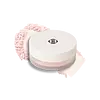Dinto Peter&Wendy Collection Pixie Dust Loose Powder Versus Fenty Beauty Bright Fix Instant Brightening + Blurring Powder
What's inside
What's inside
 Key Ingredients
Key Ingredients

 Benefits
Benefits

 Concerns
Concerns

 Ingredients Side-by-side
Ingredients Side-by-side

Mica
Cosmetic ColorantTalc
AbrasiveNylon-12
Boron Nitride
AbsorbentCI 77891
Cosmetic ColorantOctyldodecyl Stearoyl Stearate
EmollientDimethiconol Stearate
EmollientPhenyl Trimethicone
Skin ConditioningHdi/Trimethylol Hexyllactone Crosspolymer
Octyldodecanol
EmollientCaprylic/Capric Triglyceride
MaskingDiisostearyl Malate
EmollientLauroyl Lysine
Skin ConditioningCI 77492
Cosmetic ColorantDimethicone
EmollientCI 77491
Cosmetic ColorantCI 19140
Cosmetic ColorantDipentaerythrityl Hexahydroxystearate/Hexastearate/Hexarosinate
Skin ConditioningEthylhexylglycerin
Skin ConditioningCI 77499
Cosmetic ColorantCI 15850
Cosmetic ColorantGlyceryl Caprylate
EmollientMagnesium Myristate
Silica
AbrasiveWater
Skin ConditioningMica, Talc, Nylon-12, Boron Nitride, CI 77891, Octyldodecyl Stearoyl Stearate, Dimethiconol Stearate, Phenyl Trimethicone, Hdi/Trimethylol Hexyllactone Crosspolymer, Octyldodecanol, Caprylic/Capric Triglyceride, Diisostearyl Malate, Lauroyl Lysine, CI 77492, Dimethicone, CI 77491, CI 19140, Dipentaerythrityl Hexahydroxystearate/Hexastearate/Hexarosinate, Ethylhexylglycerin, CI 77499, CI 15850, Glyceryl Caprylate, Magnesium Myristate, Silica, Water
Mica
Cosmetic ColorantSynthetic Fluorphlogopite
Magnesium Myristate
Polymethyl Methacrylate
Silica
AbrasiveTapioca Starch
Lauroyl Lysine
Skin ConditioningSaccharomyces Ferment
Skin ConditioningOctyldodecyl Stearoyl Stearate
EmollientBoron Nitride
AbsorbentDiisostearyl Malate
EmollientSqualane
EmollientWater
Skin Conditioning1,2-Hexanediol
Skin ConditioningCaprylyl Glycol
EmollientStearoyl Glutamic Acid
CleansingPolymethylsilsesquioxane
Iron Oxides
Mica, Synthetic Fluorphlogopite, Magnesium Myristate, Polymethyl Methacrylate, Silica, Tapioca Starch, Lauroyl Lysine, Saccharomyces Ferment, Octyldodecyl Stearoyl Stearate, Boron Nitride, Diisostearyl Malate, Squalane, Water, 1,2-Hexanediol, Caprylyl Glycol, Stearoyl Glutamic Acid, Polymethylsilsesquioxane, Iron Oxides
 Reviews
Reviews

Ingredients Explained
These ingredients are found in both products.
Ingredients higher up in an ingredient list are typically present in a larger amount.
Boron Nitride is compound consisting of boron and nitrogen. It is used to absorb oil and modify adherence/ slip in products.
This means it is often used in makeup products to help them last longer.
Diisostearyl Malate is an emollient and most often used in lip products. It comes from isostearyl alcohol, a fatty acid, and malic acid, an AHA.
As an emollient, Diisostearyl Malate helps create a thin film on your skin to trap moisture in. This helps keep your skin soft and smooth.
This ingredient comes from a fatty acid (lauric acid) and amino acid (lysine). It is used to add a silky feel to cosmetics.
According to a manufacturer, its fatty acid base leaves a silky feeling on the skin. It also has emollient properties because of this. Emollients help soften skin by preventing water from evaporating.
Lauroyl lysine is barely soluble in water.
Learn more about Lauroyl LysineWe don't have a description for Magnesium Myristate yet.
Mica is a naturally occurring mineral used to add shimmer and color in cosmetics. It can also help improve the texture of a product or give it an opaque, white/silver color.
Serecite is the name for very fine but ragged grains of mica.
This ingredient is often coated with metal oxides like titanium dioxide. Trace amounts of heavy metals may be found in mica, but these metals are not harmful in our personal products.
Mica has been used since prehistoric times throughout the world. Ancient Egyptian, Indian, Greek, Roman, Aztec, and Chinese civilizations have used mica.
Learn more about MicaOctyldodecyl Stearoyl Stearate is created from stearic acid.
It is an emollient and thickens the lipid (oil) portion of a product. Due to its emollient properties, it may not be fungal-acne safe.
Silica, also known as silicon dioxide, is a naturally occurring mineral. It is used as a fine, spherical, and porous powder in cosmetics.
Though it has exfoliant properties, the function of silica varies depending on the product.
The unique structure of silica enhances the spreadability and adds smoothness, making it a great texture enhancer.
It is also used as an active carrier, emulsifier, and mattifier due to its ability to absorb excess oil.
In some products, tiny microneedles called spicules are made from silica or hydrolyzed sponge. When you rub them in, they lightly polish away dead skin layers and enhance the penetration of active ingredients.
Learn more about SilicaWater. It's the most common cosmetic ingredient of all. You'll usually see it at the top of ingredient lists, meaning that it makes up the largest part of the product.
So why is it so popular? Water most often acts as a solvent - this means that it helps dissolve other ingredients into the formulation.
You'll also recognize water as that liquid we all need to stay alive. If you see this, drink a glass of water. Stay hydrated!
Learn more about Water